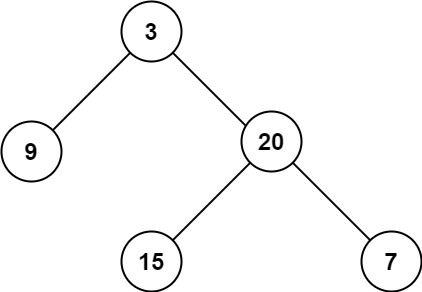Welcome to Subscribe On Youtube
104. Maximum Depth of Binary Tree
Description
Given the root of a binary tree, return its maximum depth.
A binary tree's maximum depth is the number of nodes along the longest path from the root node down to the farthest leaf node.
Example 1:

Input: root = [3,9,20,null,null,15,7] Output: 3
Example 2:
Input: root = [1,null,2] Output: 2
Constraints:
- The number of nodes in the tree is in the range
[0, 104]. -100 <= Node.val <= 100
Solutions
Solution 1: Recursion
Recursively traverse the left and right subtrees, calculate the maximum depth of the left and right subtrees, and then take the maximum value plus $1$.
The time complexity is $O(n)$, where $n$ is the number of nodes in the binary tree. Each node is traversed only once in the recursion.
-
/** * Definition for a binary tree node. * public class TreeNode { * int val; * TreeNode left; * TreeNode right; * TreeNode() {} * TreeNode(int val) { this.val = val; } * TreeNode(int val, TreeNode left, TreeNode right) { * this.val = val; * this.left = left; * this.right = right; * } * } */ class Solution { public int maxDepth(TreeNode root) { if (root == null) { return 0; } int l = maxDepth(root.left); int r = maxDepth(root.right); return 1 + Math.max(l, r); } } -
/** * Definition for a binary tree node. * struct TreeNode { * int val; * TreeNode *left; * TreeNode *right; * TreeNode() : val(0), left(nullptr), right(nullptr) {} * TreeNode(int x) : val(x), left(nullptr), right(nullptr) {} * TreeNode(int x, TreeNode *left, TreeNode *right) : val(x), left(left), right(right) {} * }; */ class Solution { public: int maxDepth(TreeNode* root) { if (!root) return 0; int l = maxDepth(root->left), r = maxDepth(root->right); return 1 + max(l, r); } }; -
# Definition for a binary tree node. # class TreeNode: # def __init__(self, val=0, left=None, right=None): # self.val = val # self.left = left # self.right = right class Solution: def maxDepth(self, root: TreeNode) -> int: if root is None: return 0 l, r = self.maxDepth(root.left), self.maxDepth(root.right) return 1 + max(l, r) -
/** * Definition for a binary tree node. * type TreeNode struct { * Val int * Left *TreeNode * Right *TreeNode * } */ func maxDepth(root *TreeNode) int { if root == nil { return 0 } l, r := maxDepth(root.Left), maxDepth(root.Right) return 1 + max(l, r) } -
/** * Definition for a binary tree node. * class TreeNode { * val: number * left: TreeNode | null * right: TreeNode | null * constructor(val?: number, left?: TreeNode | null, right?: TreeNode | null) { * this.val = (val===undefined ? 0 : val) * this.left = (left===undefined ? null : left) * this.right = (right===undefined ? null : right) * } * } */ function maxDepth(root: TreeNode | null): number { if (root === null) { return 0; } return 1 + Math.max(maxDepth(root.left), maxDepth(root.right)); } -
/** * Definition for a binary tree node. * function TreeNode(val, left, right) { * this.val = (val===undefined ? 0 : val) * this.left = (left===undefined ? null : left) * this.right = (right===undefined ? null : right) * } */ /** * @param {TreeNode} root * @return {number} */ var maxDepth = function (root) { if (!root) return 0; const l = maxDepth(root.left); const r = maxDepth(root.right); return 1 + Math.max(l, r); }; -
// Definition for a binary tree node. // #[derive(Debug, PartialEq, Eq)] // pub struct TreeNode { // pub val: i32, // pub left: Option<Rc<RefCell<TreeNode>>>, // pub right: Option<Rc<RefCell<TreeNode>>>, // } // // impl TreeNode { // #[inline] // pub fn new(val: i32) -> Self { // TreeNode { // val, // left: None, // right: None // } // } // } use std::rc::Rc; use std::cell::RefCell; impl Solution { fn dfs(root: &Option<Rc<RefCell<TreeNode>>>) -> i32 { if root.is_none() { return 0; } let node = root.as_ref().unwrap().borrow(); 1 + Self::dfs(&node.left).max(Self::dfs(&node.right)) } pub fn max_depth(root: Option<Rc<RefCell<TreeNode>>>) -> i32 { Self::dfs(&root) } }